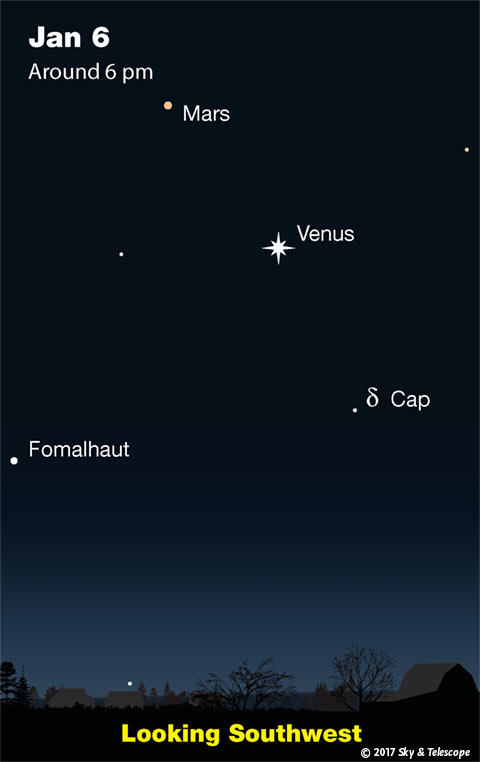
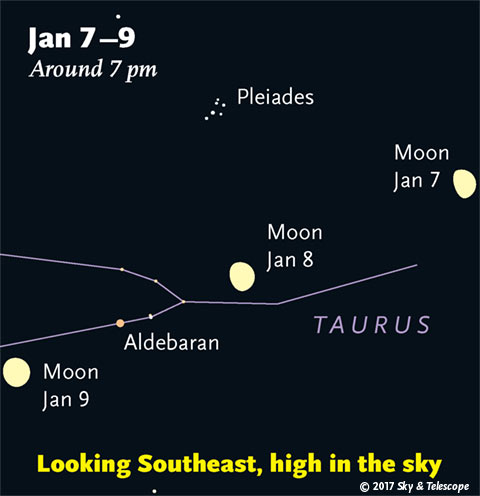
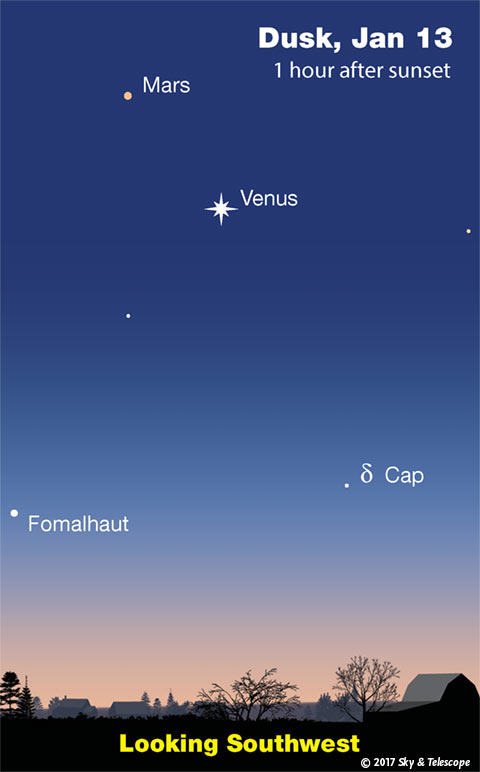
Friday, January 6
• Look above the Moon this evening for the two or three brightest stars of Aries.
• This is the time of the year when Cassiopeia passes highest, just north of overhead, right after dark. When it's in this position, Cassiopeia is a flattened letter M.
Saturday, January 7
• Aldebaran shines well to the left or lower left of the waxing gibbous Moon this evening. Upper right of Aldebaran, spot the Pleiades through the moonlight.
• In this coldest time of the year, the dim Little Dipper hangs straight down from Polaris after dinnertime — as if, per Leslie Peltier, from a nail on the cold north wall of the sky.
• The Big Dipper, meanwhile, is creeping up in the north-northeast. Its handle is very low and its bowl is to the upper right.
• The deep, flat-bottomed eclipsing binary star RW Tauri drops from 8th to 12th magnitude and back this evening (centered on 9:30 p.m. EST). See the observing project in the January Sky & Telescope, page 48.
Sunday, January 8
• The waxing gibbous Moon shines below the Pleiades and right of Aldebaran this evening.
• Late tonight the dark limb of the Moon occults 4th-magnitude Gamma Tauri for most of western and central North America; map and timetables.
Monday, January 9
• Now the Moon shines to Aldebaran's lower left during evening for North America. The Moon occults Aldebaran for Arabia, India, China, and Japan; map and timetables.
Tuesday, January 10
• The Moon, nearly full, shines in the dim Club of Orion — with Betelgeuse to its lower right in early evening, Gemini's Alhena closer to the Moon's lower left, and Elnath in Taurus above it.
• Algol shines at minimum light, magnitude 3.4 instead of its usual 2.1, for a couple hours centered on 9:19 p.m. EST (6:19 p.m. PST).
Wednesday, January 11
• Full Moon tonight (exactly full at 6:34 a.m. Thursday morning EST). The Moon is in Gemini, with Castor and Pollux to its left and Procyon below or lower left of it.
Thursday, January 12
• Neptune is passing Venus. For North American observers they'll appear closest this evening, about 0.4° apart, with Neptune to Venus's lower left. Use high power to try to discern the nonstellar nature of its tiny disk, only 2.2 arcseconds wide. Venus is magnitude –4.5. Neptune, at magnitude 7.9, is about 100,000 times fainter!
• Jupiter is at western quadrature, 90° west of the Sun. So all this month, Jupiter's western limb looks distinctly more shadowed in a telescope than its slightly more Sun-facing eastern limb.
Friday, January 13
• Here it is the coldest month of the year, but the "Summer Star," Vega, is still barely hanging in there. Look for it twinkling over the northwest horizon during and shortly after nightfall. The farther north you are the higher it will be. If you're too far south, it's already gone.
Saturday, January 14
• The waning gibbous Moon shines near Regulus, after they rise around 8 p.m. Watch the distance between them increase through the night as the Moon moves east along its orbit.
_________________________
Want to become a better astronomer? Learn your way around the constellations! They're the key to locating everything fainter and deeper to hunt with binoculars or a telescope.
This is an outdoor nature hobby. For an easy-to-use constellation guide covering the whole evening sky, use the big monthly map in the center of each issue of Sky & Telescope, the essential guide to astronomy.
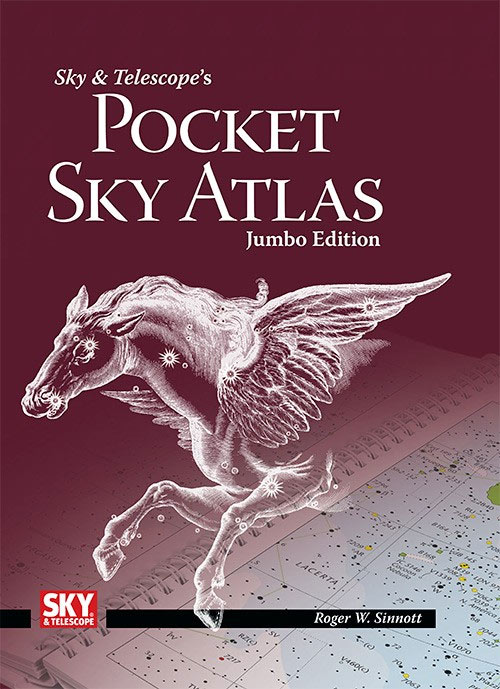
Once you get a telescope, to put it to good use you'll need a detailed, large-scale sky atlas (set of charts). The basic standard is the Pocket Sky Atlas (in either the original or new Jumbo Edition), which shows stars to magnitude 7.6.
Next up is the larger and deeper Sky Atlas 2000.0, plotting stars to magnitude 8.5; nearly three times as many. The next up, once you know your way around, is the even larger Uranometria 2000.0 (stars to magnitude 9.75). And read how to use sky charts with a telescope.
You'll also want a good deep-sky guidebook, such as Sue French's Deep-Sky Wonders collection (which includes its own charts), Sky Atlas 2000.0 Companion by Strong and Sinnott, or the bigger Night Sky Observer's Guide by Kepple and Sanner.
Can a computerized telescope replace charts? Not for beginners, I don't think, and not on mounts and tripods that are less than top-quality mechanically (meaning heavy and expensive). And as Terence Dickinson and Alan Dyer say in their Backyard Astronomer's Guide, "A full appreciation of the universe cannot come without developing the skills to find things in the sky and understanding how the sky works. This knowledge comes only by spending time under the stars with star maps in hand."
This Week's Planet Roundup
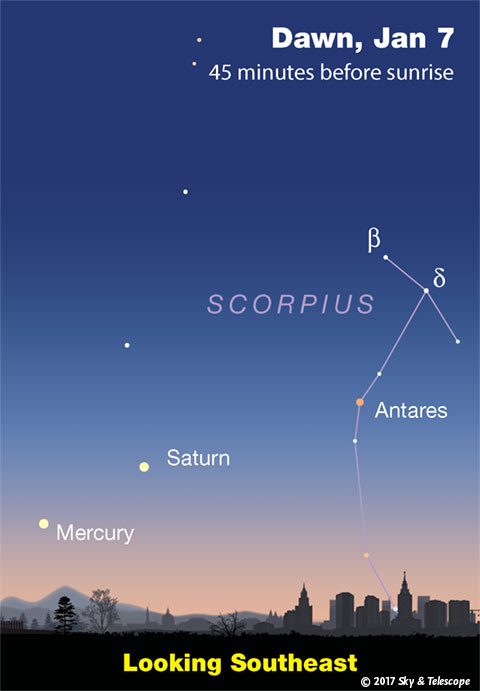
Mercury and Saturn are low in the southeast in early dawn. Mercury is 7° or 8° to Saturn's lower left this week, brightening from magnitude +0.6 to –0.1. Saturn stays at magnitude +0.5. Antares, magnitude +1.0, twinkles 14° to Saturn's right or upper right.
Venus is the bright white "Evening Star" this winter, high in the southwest during and after twilight. It's currently magnitude –4.5, in Aquarius. In a telescope Venus appears very nearly half-lit, and it's growing larger as it approaches us: it's now 24 arcseconds from cusp to cusp.
When will Venus appear exactly half lit? Technically this happens on January 14th. But because sunlight skims Venus's cloudtops at a low angle near the terminator, illuminating them rather dimly, Venus appears half-lit (at dichotomy) to most observers roughly a week or so earlier. When will it seem so to you? This offset is called the Schröter effect, and its history is told in the January Sky & Telescope, page 52.
Venus in a telescope is least glary when viewed in bright twilight, so get your telescope on it as soon as you can see it naked-eye.

Mars (magnitude +1.0, in Aquarius) is the fainter orange "star" upper left of Venus. The separation between them shrinks from 10° to 8° this week. In a telescope Mars a disappointing orange fuzzblob only 5.5 arcseconds in diameter.
Jupiter (magnitude –2.0, in Virgo) rises around midnight or 1 a.m. and shines brightly high due south just before the first light of dawn. Spica dangles 4° below it. Jupiter is creamy white, but Spica is an icier shade of white with a trace of blue. In a telescope, Jupiter is 36 or 37 arcseconds in diameter, relatively small as Jupiter goes. That's because it's still far away; it won't reach opposition until April 7th.
Uranus (magnitude 5.8, in Pisces) is high in the south after dark.
Neptune (magnitude 7.9, in Aquarius) is passing Venus this week, after passing Mars last week. They appear closest, about 0.4° apart for North American observers, on the evening of January 12th; on that date you'll find Neptune to Venus's lower left. Use high power to try to discern its 8th-magnitude disk, which appears only slightly nonstellar with a diameter of just 2.2 arcseconds. Finder charts for Uranus and Neptune among their background stars.
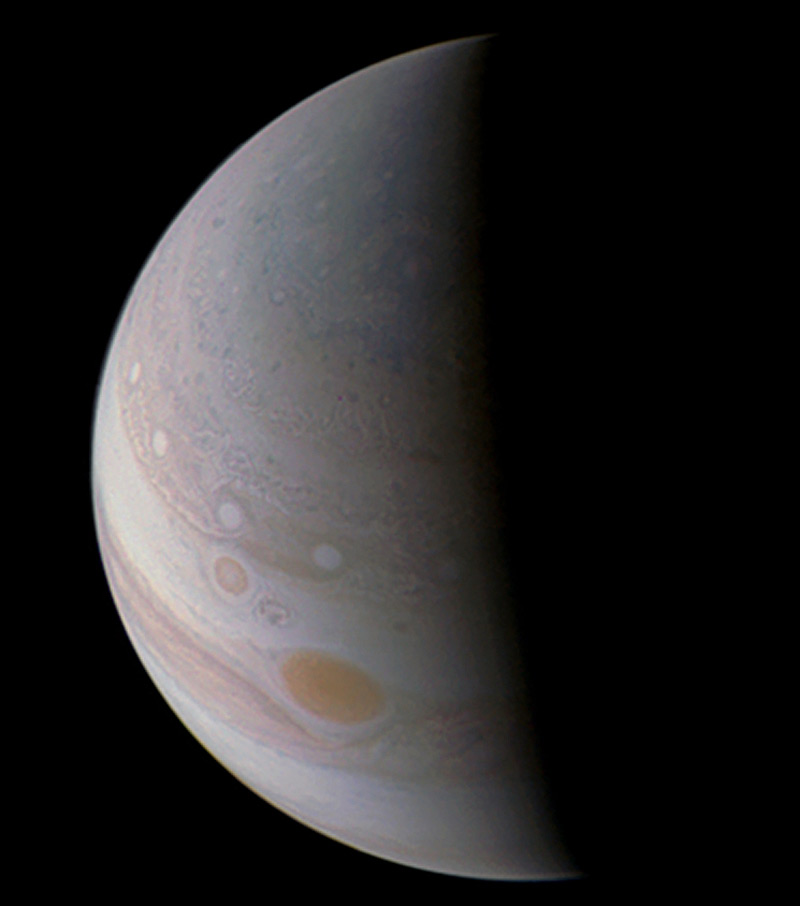
__________________________
All descriptions that relate to your horizon — including the words up, down, right, and left — are written for the world's mid-northern latitudes. Descriptions that also depend on longitude (mainly Moon positions) are for North America.
Eastern Standard Time (EST) is Universal Time (UT, UTC, or GMT) minus 5 hours.
__________________________
"This adventure is made possible by generations of searchers strictly adhering to a simple set of rules. Test ideas by experiments and observations. Build on those ideas that pass the test. Reject the ones that fail. Follow the evidence wherever it leads, and question everything. Accept these terms, and the cosmos is yours."
— Neil deGrasse Tyson
 0
0








Comments
You must be logged in to post a comment.